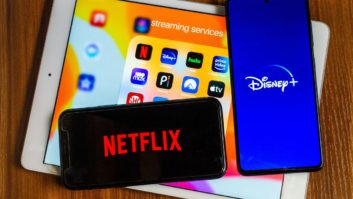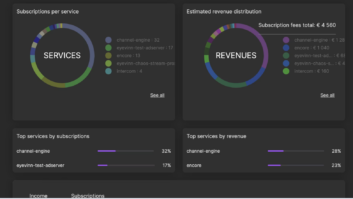
If there’s one dominant trend in today’s complex world of content distribution and access, it’s over-the-top (OTT) video delivery. While it’s true that people are not going to suddenly stop watching traditional television tomorrow, today’s savvy viewers – especially younger generations – live in a connected world in which they expect to access content on their own terms, in realtime and on demand, anywhere and on the device of their choosing.
For broadcasters, content owners, and service providers, OTT presents a tremendous opportunity to retain current viewers, reach new ones, and generate new revenue streams. In fact, the installed base of connectable TV devices is expected to more than double to over 6.3 billion devices by 2017, driving an average yearly growth rate of 28% in worldwide OTT video revenues.
OTT deployment challenges
That said, turning a profit from OTT is far from certain as established operators grapple with launching and supporting the new offerings in a manner that does not disrupt the existing business. In order to create additional revenue, OTT services require a different business model and a new process for ad management, with different processes for ad insertion, and strategies that vary from service to service. OTT business models tend to fall into four key categories: free content subsidised by advertising at pre-roll, mid-roll, and post roll (eg, YouTube and major television networks offerings), monthly subscription services such as Netflix in which advertising can supplement subscription fees, pay-per-view services in which viewers pay to watch a programme or movie within a specific time period (this applies to live channels such as sports programmes as well as video rentals), and electronic sell-through services such as Apple iTunes and Amazon Prime in which the consumer pays a one-time fee to purchase and download a media file.
Another challenge is the proliferation of different internet-connected devices for viewing OTT content, which today range from computers and laptops to smart TVs, smartphones and tablets, and even gaming consoles. As the number of devices grows, so does the complexity of delivering a consistent and high-quality experience that reinforces the brand across every platform and takes into account different operating systems, screen sizes and encoding formats.
On the back end, a critical requirement for OTT delivery is the ability to integrate the new services into traditional workflows and systems. so that functions such as content management, rights management and scheduling can be handled in a unified and efficient manner. Again, the wide variation in end user devices has added complexity. Rights management for VOD is a prime example since a single piece of content might require different rights negotiations for every delivery platform and take into account differences in timing, geographies and demographics. Likewise, on the front end operators must deliver and manage a user-friendly, attractive, and brand-consistent user interface for each different OS and device, and also ensure the security of the content.
Broadcasters face additional challenges and complexities on the content distribution end, with a bewildering number of content distribution networks (CDNs) to choose from and wide variation in pricing models, as well as a quality of experience that varies greatly from region to region and from ISP to ISP.
Elements of a managed OTT solution
Rather than trying to tackle these OTT complexities with in-house solutions, broadcasters now have another attractive and cost-effective alternative: an end-to-end managed solution from a service provider such as Globecast. Through a managed solution, broadcasters can deliver OTT services to market rapidly without having to make a capital outlay for hardware and software, keeping operating expenses under control and predictable. Plus, a service provider model can deliver cost savings through economies of scale and CDN aggregation.
To effectively address the challenges of OTT, a managed solution should cover all aspects of content preparation, management and delivery. In this model, the service provider manages the customer experience and monitors all processes from content ingest to end user delivery to ensure optimal quality of service and quality of experience. To streamline multi-platform delivery, the solution should provide features such as adaptive bit rate streaming and the ability to create multiple encoding profiles for a single piece of content based on the screen size, operating system, and other specific characteristics of the target platform. The managed solution should support delivery of both linear and non-linear content to any platform including Flash and HTML 5 players, iOS and Android devices, and connected TV, with support for current and future standards such as Smooth Streaming, HLS, HDS, and MPEG DASH. For content protection, the managed solution should support techniques such as DRM, geoblocking and token authentication. For VOD, the solution needs to provide a set of tools for content management (metadata, playlist management).
In addition, the managed solution should provide monetisation tools for squeezing out maximum revenues from every aspect of the OTT offering. These include tools for managing advertising on each type of service and platform, end user management including pay-per-view, subscriptions, and end-user authentication and rich analytics that provide accurate and multi-factor audience measurements to help shape and refine future OTT offerings.
Going global with OTT
Satellite distribution has always been the method of choice for broadcasters and content owners seeking to reach the far corners of the earth, on every TV set. Now TV viewers ask for TV everywhere on any device. The internet, of course, is global, so OTT is an ideal framework for reaching new markets and geographical areas; therefore, it’s critical to choose a managed OTT service provider with global reach. For instance, Globecast works with Akamai to take advantage of its worldwide network of CDN edge servers. By taking on the task of identifying best-of-breed technologies for every region to be served and scaling the system to support an ever-growing audience, a managed service provider can be a broadcaster’s best weapon for meeting the challenges of OTT delivery and tapping into lucrative new markets.
By Sonia Missul, product manager, Globecast






